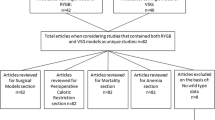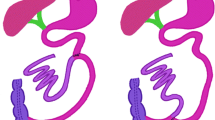Abstract
Background
Metabolic surgery is a surgical strategy which has shown great potential in the treatment of diseases which may be associated with morbid obesity. It must be developed on the basis of both animal and clinical research. The objective of this study is to set out the various options in experimentation animals and the technical characteristics in operations, and the specific animal care undertaken by our group.
Methods
We identified and reviewed the key points to be considered in animal handling during interventions such as sleeve gastrectomy, Roux-en-Y gastric bypass, ileal transposition and duodenal exclusion.
Results
The technical variations found at experimental level are due to the pouch capacity for the Roux-en-Y gastric bypass. Intestinal anastomosis is the variable with the greatest differences found between the various working groups. Ileal transposition is a technique that is undergoing constant review, and the results differ substantially depending on the animal model chosen, and are also metabolically effective in animals with a normal weight. Duodenal exclusion by means of a physical barrier has not been studied sufficiently but could be a pre-operative support for weight loss.
Conclusions
There are experimental technical discrepancies and further studies are necessary to ascertain their efficiency. Metabolic surgery currently complements bariatric surgery and justifies the appearance of new experimental studies. The animal models chosen are very important as only very specific study models will be used in cases in which the technique is sufficiently validated by the research team, as the results to be assessed depend on this.





Similar content being viewed by others
Explore related subjects
Discover the latest articles and news from researchers in related subjects, suggested using machine learning.References
Cummings D, Weigle D, Frayo R, et al. Plasma ghrelin levels after diet-induced weight loss or gastric bypass surgery. N Engl J Med. 2002;346(21):1623–30.
Xu Y, Ohinata K, Meguid MM, et al. Gastric bypass model in the obese rat to study metabolic mechanisms of weight loss. J Surg Res. 2002;107:56–63.
Cohen R. Cirugía gastrointestinal para los pacientes diabéticos tipo 2 no obesos. Rev Med Clin Condes. 2009;20(5):703–7.
Del Castillo D, Sabench F, Hernandez M, et al. The evolution of experimental surgery in the field of morbid obesity. Obes Surg. 2004;14:1263–72.
Rubino F, Marescaux J. Effect of duodenal-jejunal exclusion in a non-obese animal model of type 2 diabetes: a new perspective for an old disease. Ann Surg. 2004;239:1–11.
Rubino F, Forgione A, Cummings DE, et al. The mechanism of diabetes control after gastrointestinal bypass surgery reveals a role of the proximal small intestine in the pathophysiology of type 2 diabetes. Ann Surg. 2006;244:741–9.
DePaula AL, Macedo ALV, Rassi N, et al. Laparoscopic treatment of metabolic syndrome in patients with type 2 diabetes mellitus. Surg Endosc. 2008;22:2670–8.
Nocca D, Gagner M, Abente FC, et al. Laparoscopic gastric bypass with silicone band in a pig model: prevention of anastomotic dilatation—feasibility study. Obes Surg. 2005;15:523–7.
Tucker ON, Beglaibter N, Rosenthal RJ. Compression anastomosis for Roux-en-Y gastric bypass: observations in a large animal model. Surg Obes Relat Dis. 2008;4:115–21.
Kretschmer BD, Schelling P, Beier N, et al. Modulatory role of food, feeding regime and physical exercise on body weight and insulin resistance. Life Sci. 2005;76(14):1553–73.
Llado I, Rodriguez S, Pujol E, et al. Gender effects on adrenergic receptors expression and lipolysis in white adipose tissue of rats. Obes Res. 2002;10:296–305.
Sabench F, Hernández M, Feliu A, et al. Influence of sleeve gastrectomy on several experimental models of obesity: metabolic and hormonal implications. Obes Surg. 2008;18(1):97–108.
Clark J, Palmer CJ, Shaw WN. The diabetic Zucker fatty rat. Proc Soc Exp Biol Med. 1983;173:68–75.
Goto Y, Kakizaki M. Production of spontaneous diabetic rats by repetition of selective breeding. Tohoku J Exp Med. 1976;119:85–90.
Koyama M, Wada R, Sakuraba H, et al. Accelerated loss of islet beta cells in sucrose-fed Goto–Kakizaki rats, a genetic model of non-insulin-dependent diabetes mellitus. Am J Pathol. 1998;153(2):537–45.
Portha B, Lacraz G, Chavey A, et al. Islet structure and function in the GK rat. Adv Exp Med Biol. 2010;654:479–500.
Cummings BP, Digitale EK, Stanhope KL, et al. Physiol Regul Integr Comp Physiol. 2008;295(6):R1782–93.
Kawano K, Hirashima T, Mori S, et al. Spontaneous long-term hyperglycemic rat with diabetic complications. Otsuka Long–Evans Tokushima Fatty (OLETF) strain. Diabetes. 1992;41(11):1422–8.
Ashrafian H, Bueter M, Ahmed K, et al. Metabolic surgery: an evolution through bariatric animal models. Obes Rev. 2009;1–14.
Sivitz WI, Walsh S, Morgan D, et al. Plasma leptin in diabetic and insulin-treated diabetic and normal rats. Metabolism. 1998;47(5):584–91.
Cummings BP, Strader AD, Stanhope KL, et al. Ileal interposition surgery improves glucose and lipid metabolism and delays diabetes onset in the UCD-T2DM rat. Gastroenterology. 2010;138(7):2437–46.
Lopez PP, Nicholson SE, Burkhardt GE, et al. Development of a sleeve gastrectomy weight loss model in obese Zucker rats. J Surg Res. 2009;157(2):243–50.
Patrikakos P, Toutouzas KG, Perrea D, et al. A surgical rat model of sleeve gastrectomy with staple technique: long-term weight loss results. Obes Surg. 2009;19(11):1586–90.
Stenström B, Furnes MW, Tømmerås K, et al. Mechanism of gastric bypass-induced body weight loss: one-year follow-up after micro-gastric bypass in rats. J Gastrointest Surg. 2006;10(10):1384–91.
Sabench F, Hernández M, Blanco S, et al. The effects of ileal transposition, gastrojejunal bypass and vertical gastroplasty on the regulation of ingestion in an experimental obesity model associated with diabetes mellitus type 2. Cir Esp. 2009;85(4):222–8.
Meirelles K, Ahmed T, Culnan DM, et al. Mechanisms of glucose homeostasis after Roux-en-Y gastric bypass surgery in the obese, insulin-resistant Zucker rat. Ann Surg. 2009;249(2):277–85.
Koopmans HS, Scalfani A, Fichtner C, et al. The effects of ileal transposition on food intake and body weight loss in VMH obese rats. Am J Clin Nutr. 1982;35:284–93.
Atkinson RL, Whipple JH, Atkinson SH, et al. Role of the small bowel in regulating food intake in rats. Am J Physiol. 1982;242(5):R429–33.
Ferri GL, Koopmans HS, Ghatei MA, et al. Ileal enteroglucagon cells after ileal-duodenal transposition in the rat. Digestion. 1983;26(1):10–6.
Patriti A, Facchiano E, Annetti C, et al. Early improvement of glucose tolerance after ileal transposition in a non-obese type 2 diabetes rat model. Obes Surg. 2005;15(9):1258–64.
Patriti A, Aisa MC, Annetti C, et al. How the hindgut can cure type 2 diabetes. Ileal transposition improves glucose metabolism and beta-cell function in Goto-Kakizaki rats through an enhanced Proglucagon gene expression and l-cell number. Surgery. 2007;142:74–85.
Strader AD, Vahl T, Jandacek R, et al. Weight loss through ileal transposition is accompanied by increased ileal hormone secretion and synthesis in rats. Am J Physiol Endocrinol Metab. 2005;288(2):447–53.
Strader AD, Clausen TR, Goodin SZ, et al. Ileal interposition improves glucose tolerance in low dose streptozotocin treated diabetic and euglycemic rats. Obes Surg. 2009;19:96–104.
DePaula AL, Macedo AL, Mota BR, et al. Laparoscopic ileal interposition associated to a diverted sleeve gastrectomy is an effective operation for the treatment of type 2 diabetes mellitus patients with BMI 21–29. Surg Endosc. 2009;23:1313–20.
Tarnoff M, Rodriguez L, Escalona A, et al. Open label, prospective, randomized controlled trial of an endoscopic duodenal-jejunal bypass sleeve versus low calorie diet for pre-operative weight loss in bariatric surgery. Surg Endosc. 2009;23(3):650–6.
Schouten R, Rijs CS, Bouvy ND, et al. A multicenter, randomized efficacy study of the EndoBarrier Gastrointestinal Liner for presurgical weight loss prior to bariatric surgery. Ann Surg. 2010;251(2):236–43.
Aguirre V, Stylopoulos N, Grinbaum R, et al. An endoluminal sleeve induces substantial weight loss and normalizes glucose homeostasis in rats with diet-induced obesity. Obesity. 2008;16:2585–92.
Del Castillo D, Sabench F, Hernandez M, et al. Experimental standardization of the duodenal exclusion technique in obese animals and its application to the field of ingestion regulation. International Federation for the Surgery of Obesity and metabolic disorders. XIV World Congress: Palais des Congres (Porte Maillot). Paris, France August 26–29, 2009. Obes Surg. 2009;19:953–1076.
Troy S, Soty M, Ribeiro L, et al. Intestinal gluconeogenesis is a key factor for early metabolic changes after gastric bypass but not after gastric lap-band in mice. Cell Metab. 2008;8:201–11.
Meguid MM, Glade MJ, Middleton FA. Weight regain after Roux-en-Y: a significant 20% complication related to PYY. Nutrition. 2008;24(9):832–42.
Stylopoulos N, Davis P, Pettit JD, et al. Changes in serum ghrelin predict weight loss after Roux-en-Y gastric bypass in rats. Surg Endosc. 2005;19(7):942.
Stylopoulos N, Hoppin AG, Kaplan LM. Roux-en-Y gastric bypass enhances energy expenditure and extends lifespan in diet-induced obese rats. Obesity. 2009;17(10):1839–47.
Suzuki S, Ramos EJ, Goncalves CG, et al. Changes in GI hormones and their effect on gastric emptying and transit times after Roux-en-Y gastric bypass in rat model. Surgery. 2005;138(2):283–90.
Inoue H, Rubino F, Shimada Y, et al. Risk of gastric cancer after Roux-en-Y gastric bypass. Arch Surg. 2007;142(10):947–53.
Furnes MW, Tømmerås K, Arum CJ, et al. Gastric bypass surgery causes body weight loss without reducing food intake in rats. Obes Surg. 2008;18(4):415–22.
Tichansky DS, Boughter Jr JD, Harper J, et al. Gastric bypass surgery in rats produces weight loss modeling after human gastric bypass. Obes Surg. 2008;18(10):1246–50.
Wolff BS, Meirelles K, Meng Q, et al. Roux-en-Y gastric bypass alters small intestine glutamine transport in the obese Zucker rat. Am J Physiol Gastrointest Liver Physiol. 2009;297(3):G594–601.
Stearns AT, Balakrishnan A, Tavakkolizadeh A. Impact of Roux-en-Y gastric bypass surgery on rat intestinal glucose transport. Am J Physiol Gastrointest Liver Physiol. 2009;297(5):G950–7.
Li Z, Zhang HY, Lv LX, et al. Roux-en-Y gastric bypass promotes expression of PDX-1 and regeneration of beta-cells in Goto-Kakizaki rats. World J Gastroenterol. 2010;16(18):2244–51.
Shin AC, Zheng H, Townsend RL, et al. Meal-induced hormone responses in a rat model of Roux-en-Y gastric bypass surgery. Endocrinology. 2010;151(4):1588–97.
Author information
Authors and Affiliations
Corresponding author
Additional information
The authors declare no conflict of interest in this work. Likewise, all images are original to the authors and have been taken in the laboratory animal experimentation of the Faculty of Medicine, Rovira i Virgili University (Reus, Spain).
Rights and permissions
About this article
Cite this article
Sabench Pereferrer, F., Hernàndez Gonzàlez, M. & Del Castillo Déjardin, D. Experimental Metabolic Surgery: Justification and Technical Aspects. OBES SURG 21, 1617–1628 (2011). https://doi.org/10.1007/s11695-011-0367-4
Published:
Issue Date:
DOI: https://doi.org/10.1007/s11695-011-0367-4




